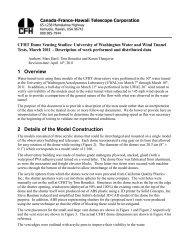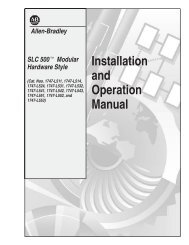Documentation [PDF] - Canada France Hawaii Telescope ...
Documentation [PDF] - Canada France Hawaii Telescope ...
Documentation [PDF] - Canada France Hawaii Telescope ...
You also want an ePaper? Increase the reach of your titles
YUMPU automatically turns print PDFs into web optimized ePapers that Google loves.
5.4 Depth and completeness limits<br />
The depth is measured the same way as in Section 4.3. The completeness limits and galaxy count plots<br />
are available in the synoptic table.<br />
The depths of D-25 and D-85 are given in Tables 18 and 19 for the median combined stacks and Tables 20<br />
and 21 for the sigma-combined stacks. These numbers are also presented in the synoptic table. The errors<br />
quoted for the completeness limits in the Tables are dominated by the fitting error. For the 80% and 50%<br />
values, this is due to sparse sampling of the curve in the magnitude range where the variations of the<br />
completeness as a function of magnitude are important.<br />
From Figure 47, the 80% completeness limits of stellar sources is a good indicator of the turn-over magnitude<br />
for the galaxy counts. Similarly, the 80% completeness limits of extended sources corresponds<br />
well to the turnover point where the galaxy counts begin to be incomplete. This is however not true for<br />
the u ∗ -band data, where both depth parameters have similar values and also for the z-band, where the<br />
completeness limit value is lower than the turnover point and appears to be a pessimistic estimate of<br />
depth.<br />
We note that the completeness limit measurements with simulated sources in the Deep data seem to be in<br />
poorer agreement with the galaxy counts plots in comparison to the Wide survey (see Fig. 28). Furthermore,<br />
the Deep D-25 estimates are closer to expectations than D-85. This is most likely a consequence<br />
of increased crowding in deeper images. In these D-85 images, the fraction of blended sources indeed<br />
increases and makes the unambiguous detection of simulated sources more and more difficult.<br />
The D2-u ∗ should be interpreted with caution. As it contains a mix of CFHTLS and COSMOS images that<br />
are shifted by 30 arc-minutes, the center of the stacks is deeper and the corners are shallower than the<br />
mean depth of the stack (see Fig. 45). Note that the total exposure times and the depths quoted in the<br />
Tables and on the figures for the D2-25-u ∗ and D2-85-u ∗ do not apply to the entire image.<br />
The D2-u ∗ is the only Deep stack with a non-uniform field coverage. The observing sequences were split<br />
into five positions of MegaCam with respect to the Deep D2 center field. They are referenced as:<br />
• the D2-cc-u ∗ center pointing;<br />
• the D2-ul-u ∗ upper left pointing, located North-East from the center field;<br />
• the D2-ur-u ∗ upper right pointing, located North-West;<br />
• the D2-ll-u ∗ lower left pointing, located South-East; and<br />
• the D2-lr-u ∗ lower right pointing, located South-West.<br />
The relative positions of D2-cc, D2-ul, D2-ur, D2-ll and D2-lr are shown on Fig. 46. The black<br />
contours outline the shape of the D2-u ∗ stacks. All colored areas located inside are combined to produce<br />
the D-25-u ∗ and D-85u ∗ , which explains the complex weightmap shown on the left panel of Fig. 45.<br />
The complex mosaic pattern and the division of observations amongst several observing runs results in<br />
a non-uniform completeness for the D2-u ∗ stacks. The exposure time and depth can only be defined<br />
locally over for the D2-u ∗ MegaCam field. Table 23 describes the observations in sub-quadrants drawn<br />
on Fig. 46. Each quadrant of D-25-u ∗ and D-85-u ∗ combines the cc images with either D2-ul, or D2-ur,<br />
or D2-ll, or D2-lr, while the central part combines them all. A global estimation of exposure time and<br />
depth for D2-u ∗ is clearly impossible. Note that the exposure times inside the bold contours of Fig. 46<br />
are 51012 s. and 142970 s., for the D2-u ∗ -25 and D2-u ∗ -85 stacks, respectively.<br />
80


![Documentation [PDF] - Canada France Hawaii Telescope ...](https://img.yumpu.com/26965302/92/500x640/documentation-pdf-canada-france-hawaii-telescope-.jpg)









